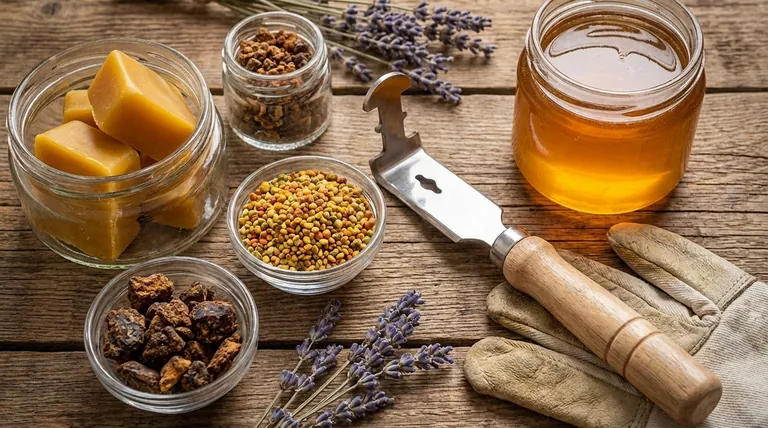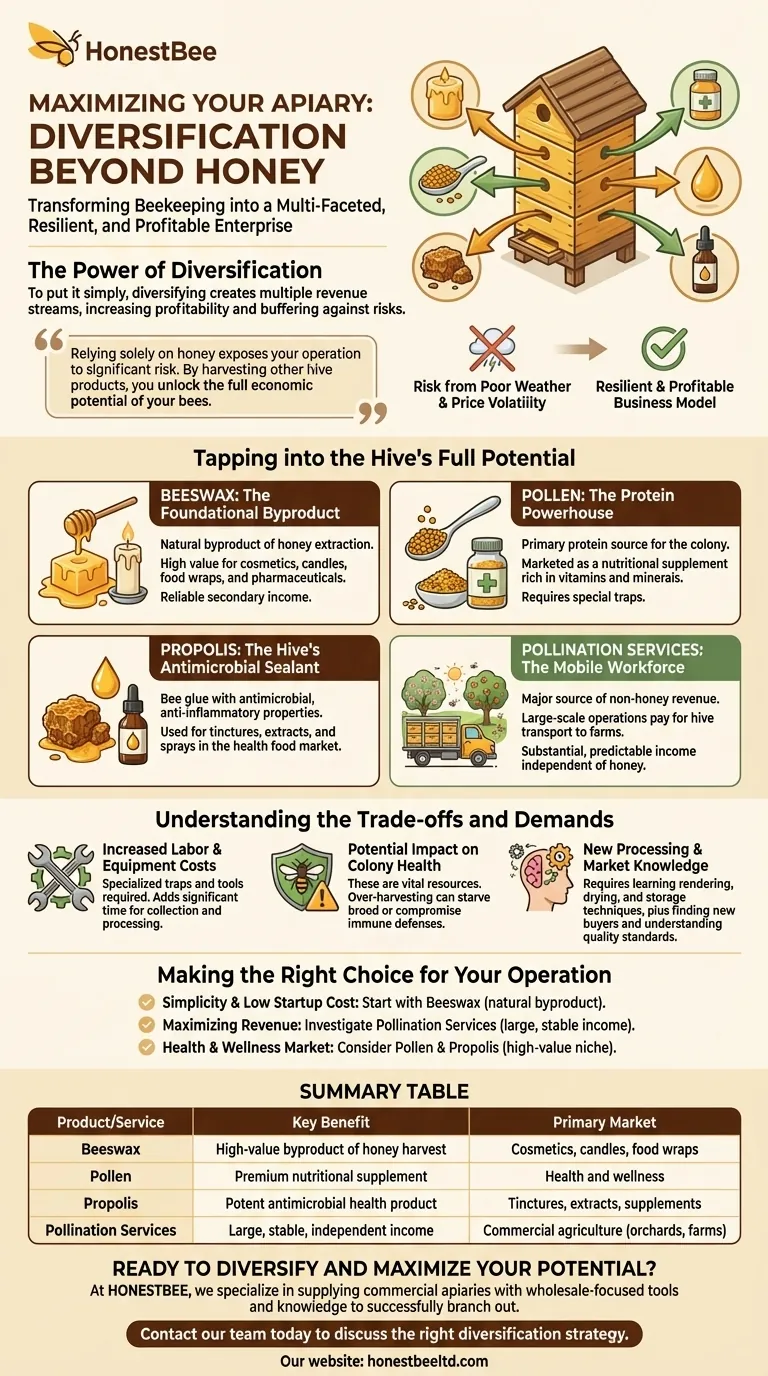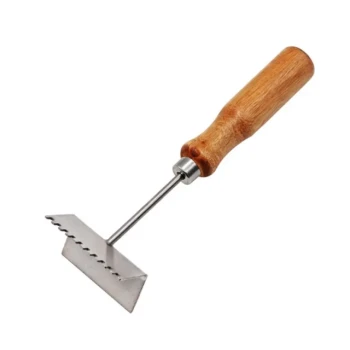To put it simply, diversifying beyond honey transforms a beekeeping operation from a single-product business into a multi-faceted enterprise. This strategy creates several additional revenue streams from the same hives, significantly increasing potential profitability and providing a crucial buffer against unpredictable honey seasons or fluctuating market prices.
Relying solely on honey exposes your operation to significant risk from poor weather and price volatility. By harvesting other hive products, you unlock the full economic potential of your bees, creating a more resilient and profitable business model.

Beyond Honey: Tapping into the Hive's Full Potential
A beehive is a complex biological engine that produces much more than just a single sweet commodity. Understanding these other products is the first step toward maximizing the value of your apiary.
Beeswax: The Foundational Byproduct
Beeswax is one of the most accessible products to harvest. It is a natural byproduct of the honey extraction process, primarily coming from the wax cappings sliced off the honeycomb.
Natural beeswax commands a high value. It is sought after for use in cosmetics, candles, food wraps, and pharmaceuticals, providing a reliable secondary income stream with minimal additional infrastructure.
Pollen: The Protein Powerhouse
Bee pollen is collected by foraging bees and is the primary protein source for the colony. For humans, it is marketed as a nutritional supplement rich in vitamins and minerals.
Beekeepers use special "pollen traps" at the hive entrance to gently scrape a portion of the pollen pellets from the bees' legs. This requires specific equipment and careful management to ensure the colony retains enough for its own needs.
Propolis: The Hive's Antimicrobial Sealant
Bees create propolis from tree resins to seal cracks in the hive and protect it from pathogens. It has powerful antimicrobial, anti-inflammatory, and antioxidant properties.
This "bee glue" is harvested by scraping it from hive components or by using special propolis traps. It is then often sold as a raw product or processed into tinctures, extracts, and sprays for the health food market.
Pollination Services: The Hive as a Mobile Workforce
Perhaps the most significant source of non-honey revenue is pollination services. Many crops, from almonds to apples, depend on honeybees for successful fruiting.
Large-scale agricultural operations pay beekeepers to transport their hives to farms and orchards during the blooming season. This can provide a substantial and predictable income that is entirely independent of honey production levels.
Understanding the Trade-offs and Demands
While diversification is powerful, it's not without its challenges. Each new product introduces unique requirements for labor, knowledge, and equipment.
Increased Labor and Equipment Costs
Harvesting pollen, propolis, or royal jelly requires specialized traps and tools. It also adds significant time and labor to your hive management schedule, from installation and collection to processing and packaging.
Potential Impact on Colony Health
These products are not waste; they are vital resources for the bees. Over-harvesting pollen can starve the brood of essential protein, while removing too much propolis can compromise the colony's immune defenses. Responsible harvesting is critical to long-term hive health.
New Processing and Market Knowledge
Selling beeswax requires learning how to properly render and filter it. Selling pollen requires knowledge of drying and storage techniques. Each product demands that you find new buyers and understand the specific quality standards of that market.
Making the Right Choice for Your Operation
Your diversification strategy should align with your goals, scale, and resources.
- If your primary focus is simplicity and low startup cost: Begin by rendering and selling the beeswax from your honey cappings, as it's a natural byproduct of your existing process.
- If your primary focus is maximizing revenue from a large apiary: Investigate offering pollination services, as this can become your most significant and stable income source.
- If your primary focus is the health and wellness market: Consider adding pollen and propolis collection, which requires more specialized equipment but targets a high-value niche.
By viewing your hives as a source of multiple valuable products, you can build a more robust, profitable, and sustainable beekeeping business.
Summary Table:
| Product/Service | Key Benefit | Primary Market |
|---|---|---|
| Beeswax | High-value byproduct of honey harvest | Cosmetics, candles, food wraps |
| Pollen | Premium nutritional supplement | Health and wellness |
| Propolis | Potent antimicrobial health product | Tinctures, extracts, supplements |
| Pollination Services | Large, stable, independent income | Commercial agriculture (orchards, farms) |
Ready to diversify your apiary and maximize your hive's potential?
At HONESTBEE, we specialize in supplying commercial apiaries and beekeeping equipment distributors with the wholesale-focused tools and knowledge needed to successfully branch out. Whether you're scaling up pollination services or adding propolis collection, we provide the durable equipment and expert support to help you build a more profitable and resilient business.
Contact our team today to discuss the right diversification strategy for your operation.
Visual Guide

Related Products
- Professional Stainless Steel Frame Cleaner with Ergonomic Wood Handle
- Wide Adjustable Stainless Steel Honey Uncapping Fork with Scraper
- Stainless Steel Double Sided Honey Uncapping Fork with Scraper
- Professional Wide Blade Honey Scraper for Beekeeping and Honey Processing
- Professional Stainless Steel J-Hook Hive Tool
People Also Ask
- How often should the area under beehives be inspected and cleaned during the warm season? A Proactive Maintenance Guide
- What is the function of a hive tool in beekeeping? The Essential Multi-Purpose Lever for Your Hive
- When is the frame cleaning tool especially useful? Essential for Efficient Frame Reuse in Beekeeping
- When is the best time to perform scraping maintenance on hive surfaces? Minimize Stress for a Healthier Colony
- What are the two main care and maintenance tasks for hive tools? Protect Your Hives and Your Investment



















